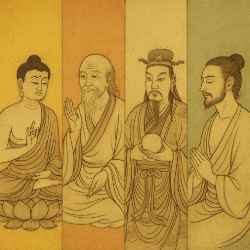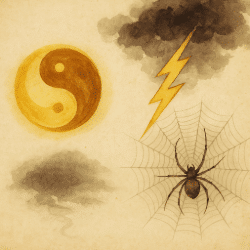Talk to anyone on a spiritual path long enough—whether they’re meditating, training in martial arts, or just trying to live with a little more wisdom—and sooner or later someone brings up enlightenment. But what exactly does that mean?
The truth is, it depends who you ask.
“Enlightenment” can mean anything from waking up from illusion, to becoming immortal, to unlocking a fully unified mind. In this guide, we’ll break down the differences in how Buddhism, Classical Taoism, Sectarian Taoism, and the 4 Ascendant Tradition each define enlightenment—and why that matters if you’re walking any kind of path toward awareness, transformation, or mastery.
Buddhism: Liberation Through Realization
In most forms of Buddhism, enlightenment means freedom from suffering (dukkha) and the end of the cycle of rebirth (samsara). That liberation comes through the realization that:
There is no permanent self (anatta)
Craving leads to suffering
Letting go leads to peace
Enlightenment is often described as awakening, a deep shift in consciousness where one sees through illusion and becomes detached from ego, desire, and clinging.
In Zen, this can come suddenly—like being struck by lightning. In Theravāda, it’s usually a stepwise process through insight meditation. Either way, it’s a cognitive transformation: you see through the dream.
Key Traits: Insight, no-self, ending suffering
Method: Meditation, ethics, renunciation
Result: A peaceful, non-clinging awareness
Classical Taoism: Flowing with the Tao
In Classical Taoism—as taught in the Tao Te Ching and Zhuangzi—enlightenment doesn’t mean escape. It means return: returning to one’s natural state and re-aligning with the Tao, the underlying rhythm of reality.
The enlightened person in Taoism doesn’t seek perfection or purity. Instead, they act without effort (wu wei), follow natural rhythms, and abandon artificial goals. Like water, they take the shape of the moment. Like the uncarved block (pu), they remain simple and whole.
Rather than a sudden awakening, Classical Taoist enlightenment is a quiet erosion of interference—less about knowing and more about forgetting.
Key Traits: Simplicity, spontaneity, quiet alignment
Method: Observation, letting go, flowing
Result: Harmony with the Tao and effortless action
Sectarian Taoism: Alchemical Immortality
Later religious or sectarian Taoist traditions—like those found in the Shangqing and Zhengyi schools—often defined enlightenment in more technical, energetic terms.
Practitioners sought to refine their internal energies through practices like:
Breathwork
Internal alchemy (neidan)
Meditation on celestial deities and symbols
The goal? Becoming an immortal (xian), or at least achieving a body-spirit union that transcends ordinary death.
To these traditions, enlightenment was an elevated vibrational state—a transmutation of the self into something luminous, lasting, and in harmony with celestial realms.
Key Traits: Energy refinement, immortality, divine integration
Method: Alchemy, visualization, ritual
Result: A radiant subtle body or immortal presence
The 4 Ascendant Tradition: The Unified Mind and Energetic Activation
The 4 Ascendant Tradition (4AS) offers a distinctly modern but deeply esoteric view of enlightenment. It emphasizes not just insight or flow, but functional transformation of the self at a foundational level.
Central to this is the model of the Three Minds:
Intellect – The thinking, rational, planning mind
Emotional – The reactive, socially conditioned heart-mind
Intuitive – The instinctive, body-based perceptive mind
In ordinary people, these minds are in conflict. They pull in different directions—thinking one thing, feeling another, acting a third. Enlightenment in 4AS is the unification of these minds into a single, coherent Hybrid Mind.
But this integration is more than psychological. It’s energetic.
Practitioners undergo structured training—ritual, breathwork, meditation, and subtle body alignment—that gradually synchronizes the minds. At a key point, ling is triggered. This is a term for spiritual activation, where the body-mind system ignites into a new functional mode.
The result is not detachment, but enhanced perception, power, and harmony—a being who can act precisely, perceive deeply, and live as a coherent whole.
Key Traits: Integration, energetic awakening, embodied realization
Method: Training the minds, breath, ritual, ling activation
Result: Unified consciousness with real-world precision and presence
Which Path Is Right for You?
If you’re someone who:
Craves freedom from emotional pain → Buddhism may offer clarity.
Wants to live more naturally and simply → Classical Taoism’s your flow.
Seeks mystical transformation or hidden power → Sectarian Taoism holds keys.
Is drawn to embodied change, liberation from society, or energetic mastery → 4AS might be your map.
What matters isn’t the label—it’s how you live the transformation. Whether you’re sitting in zazen, practicing forms in the woods, or doing subtle breath rituals by candlelight, every tradition has something to offer the journey.
Final Thought: Different Trails, Same Summit?
In truth, these systems don’t contradict each other. They offer different views of the same mountain, shaped by different climates, tools, and languages. Some focus on liberation, others on alignment, others on transformation.
But all of them agree on this: there is a way to live beyond fragmentation, beyond suffering, beyond the illusion of separateness.
And that’s worth walking toward—whichever trail you choose.
Frequently Asked Questions
In Buddhism, enlightenment means awakening from suffering and realizing the illusion of a permanent self. It leads to inner peace and freedom from the cycle of rebirth.
Classical Taoism focuses on aligning with the Tao through simplicity and spontaneity, while Buddhism emphasizes detachment and insight into the nature of suffering and self.
Sectarian Taoist traditions often involve internal alchemy and rituals aimed at energetic refinement or achieving immortality, emphasizing transformation over detachment.
The 4 Ascendant Tradition sees enlightenment as the integration of the Intellect, Emotional, and Intuitive minds into a unified Hybrid Mind, activated by an energetic process called ling.
Each tradition offers different strengths—choose the one that aligns with your goals, whether that's inner peace, natural living, mystical transformation, or energetic integration.



